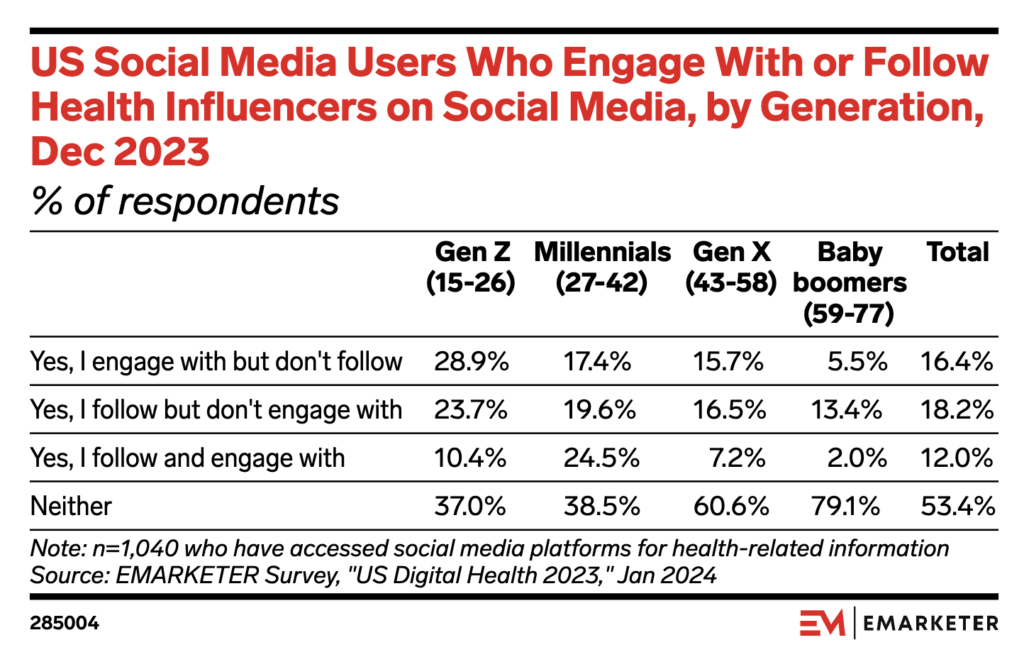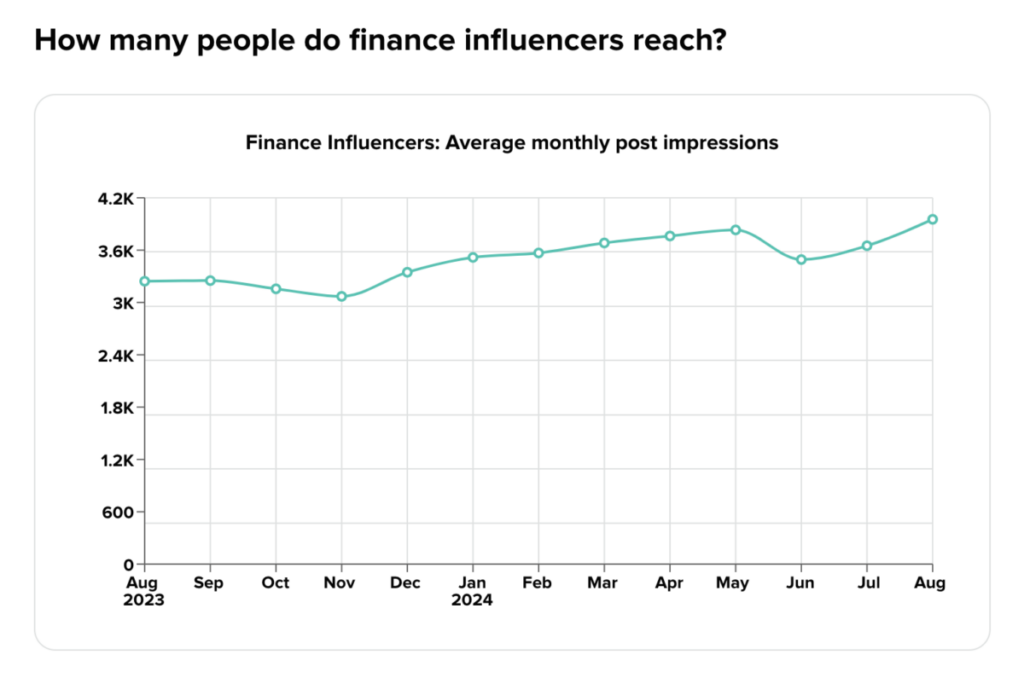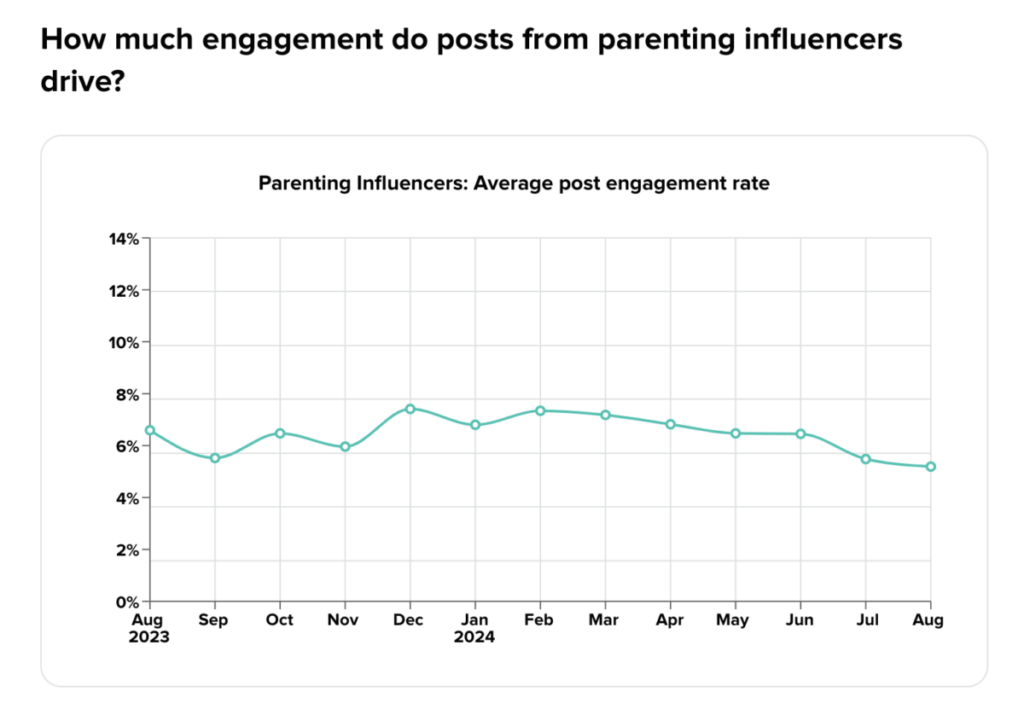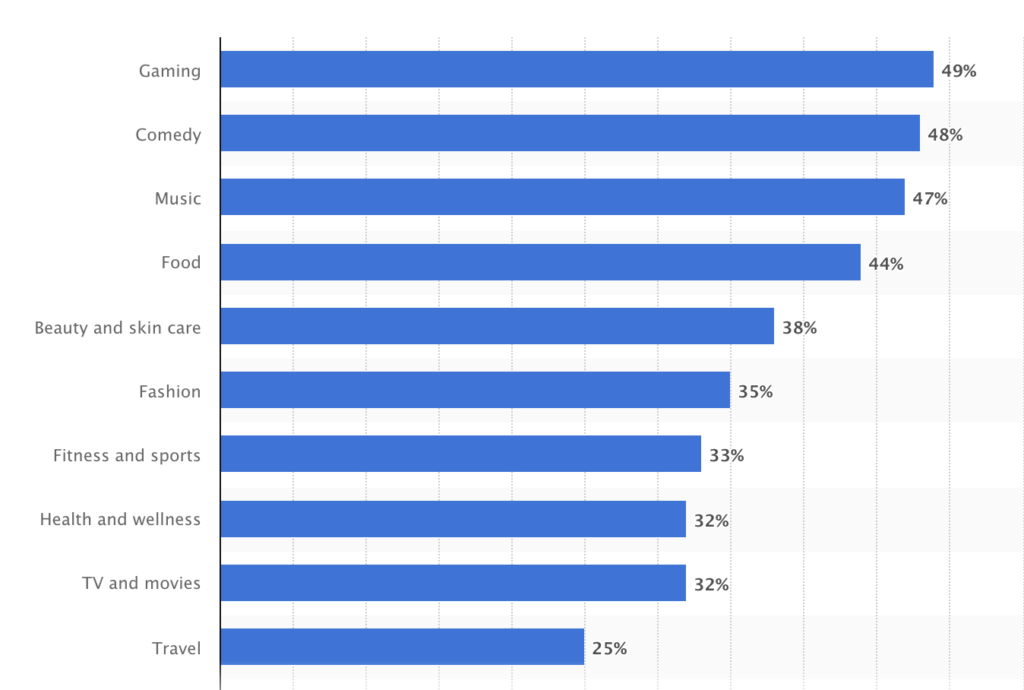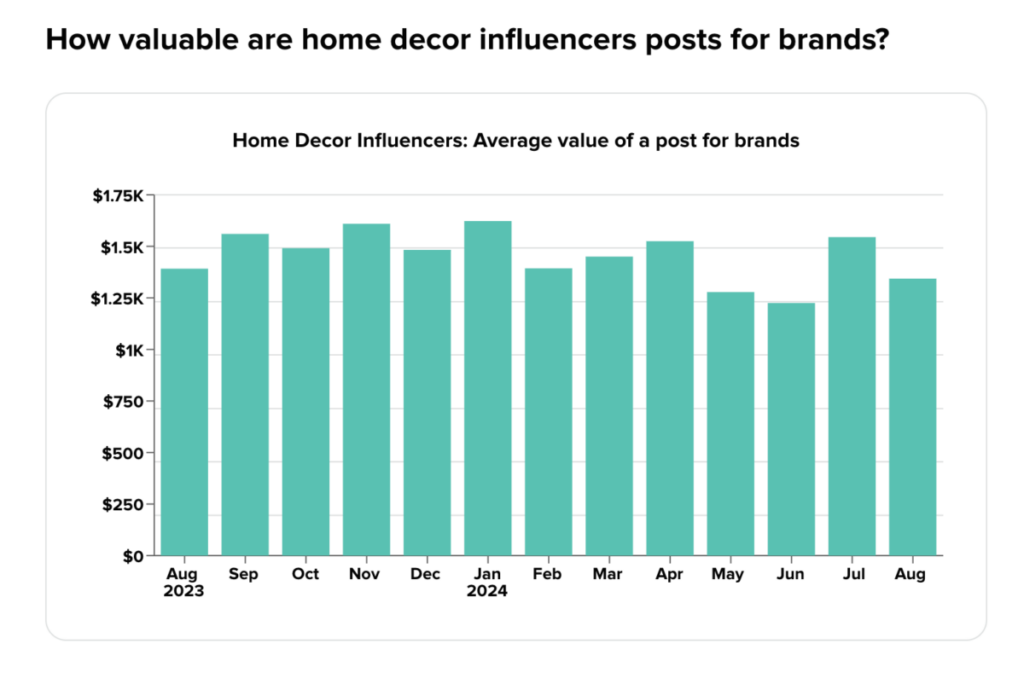You can have the brightest marketing ideas, but if you’ve chosen a niche market with low engagement and fierce competition it will feel like you’ll have one hand tied behind your back. Brand strategists and managers looking to sharpen their competitive edge and improve their return on investment need to tap into emerging trends and the niche markets that pop up as a result.
Our The State of Influencer Marketing 2024: Benchmark Report underscores the value of reaching a specific, dedicated audience over a broad group. We found that even more brands plan to rely mostly on nano-influencers, up from 39% in 2023 to 44% in 2024.
Here are the most popular and profitable influencer niches for digital marketers and influencer marketing agencies, along with ideas on how to target customer segments more effectively.
Top 11 Most Profitable and Trending Influencer Niches in 2024
1. Health and Wellness (Fitness, Mental Health, and Well-Being)
While Googling your symptoms is seldom a good idea, social media platforms have become a hub of health and wellness content. In addition to the general fitness and mental well-being tips, there are also health-related sub-niches like holistic wellness, mental advocacy, and fitness transformations emerging.
The health influencer niche is significantly more popular among Gen Z and millennial consumers. According to EMARKETER’s 2023 US Digital Health Survey, nearly a quarter (24.5%) of millennials follow and engage with health influencers while 28.9% of Gen Zers engage with (but don’t follow) influencers in this category.
On the other hand, less than 10% of Gen Z and baby boomers follow and engage with health influencers on social media.
For example, Gymshark, a British-based, multinational fitness apparel retailer, uses influencer marketing, specifically on TikTok. As the company’s mission is to create a fan-led community, this marketing strategy fits as perfectly as the products they’re selling. House of Marketers, one of the top TikTok influencer marketing agencies that helped the brand to onboard Instagram influencers too, shares in one of their influencer marketing success stories that with help of influencers Gymshark grew to a business worth £100 million in just seven years.
@jessicabickling A sports bra and sweats combo on upper body day is undefeated @Gymshark ♬ The Machine – Reed Wonder & Aurora Olivas
2. Sustainable Living and Eco-Friendly Products
Sustainability is more than a trend. It’s a top concern that drives consumer behavior, especially among Gen Z and millennials. According to Deloitte’s 2024 Gen Z and Millennial Survey, 62% of Gen Zers and 59% of millennials reported feeling anxious about climate change in the past month.
Even more are actively taking action. The same survey found that over 70% of Gen Zs and millennials are taking action to reduce their impact on the environment.
For a brand like The Body Shop that uses raw, natural ingredients in their products, it makes sense to work with influencers who post about skin care as well as sustainable practices. To attract influencers in these niches, they’ve created an influencer program.
They’ve, for example, worked with Gemma Styles, an award-winning podcaster and pro-planet Instagram influencer with over 10 million followers, and Kaushal, an influencer who promotes wellness conscious living.
3. Personal Finance and Financial Literacy
Once a field reserved to traditional settings like lecture halls and newspapers, personal finance is now a topic that resonates across social media, in particular YouTube and X. Finance influencers like John Liang, Josh Rincon, and Delyanne Barros are taking it upon themselves to bridge the generational gap and make financial literacy more accessible by leveraging the platforms younger audiences frequent.
This shift is partly fueled by the growing need for financial literacy among millennials and Generation Z. According to a survey completed by EMARKETER, only 39.6% of Gen Z save for long-term goals like retirement.
In 2024, finance influencers started posting more frequently and they’ve been rewarded with more post impressions as the average monthly post impressions jumped from about 3,300 to nearly 4,200 in a year. This shows that audiences are receptive to learning more about finance via platforms that are associated more with socializing than strategizing.
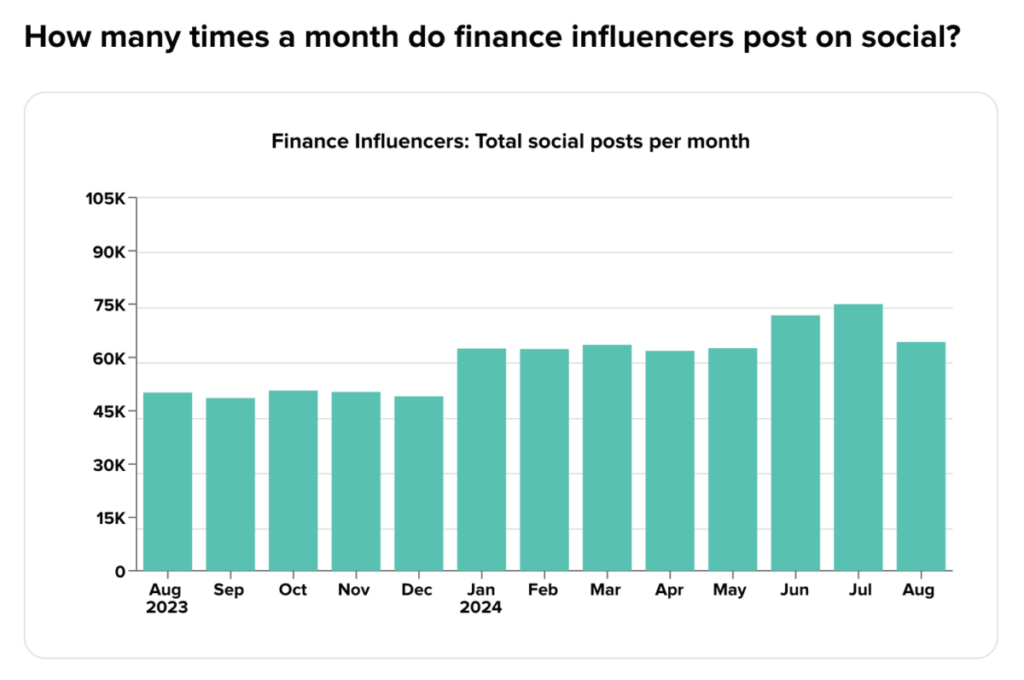
The demand for financial knowledge, products, and apps makes this a profitable niche for brands. Sprout Social estimates the average value of finance influencer posts for brands at between $1,400 and $1,750.
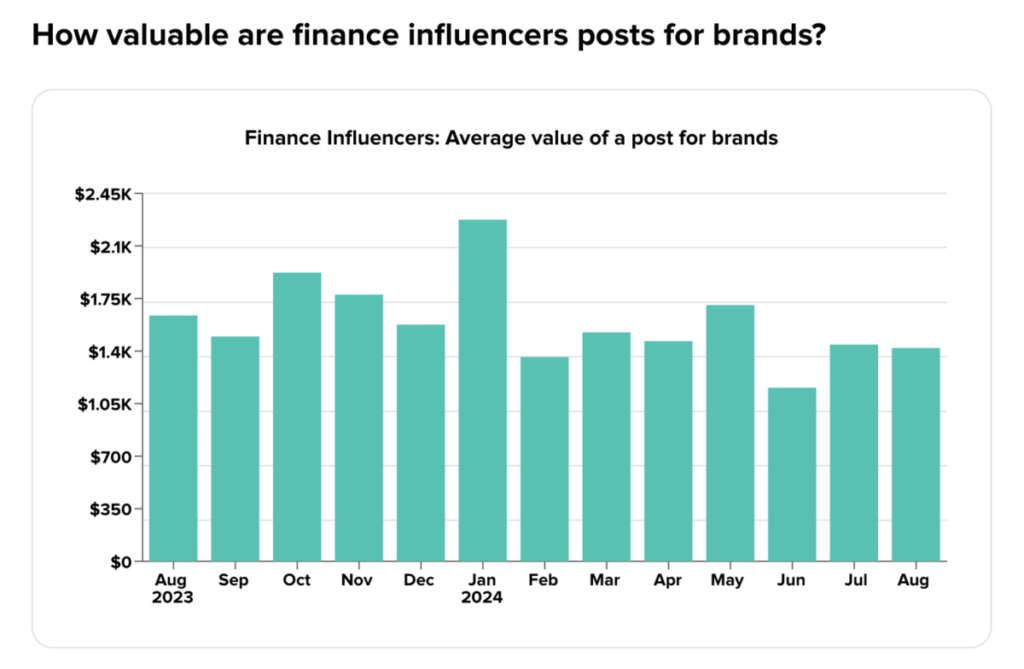
4. Parenting and Family Life
Parenting is a high-engagement niche for brands in baby care, home products, and family-focused content. According to data pulled from Tagger by Sprout Social, parenting influencers boast an average post engagement rate of about 6%.
Our The State of Influencer Marketing 2024: Benchmark Report puts the average engagement rate at 2.05% for Instagram and between 1.9% and 3.47% for YouTube. This means that depending on the platform and influencer’s audience size, you can expect double (if not more) the average engagement rate in this niche.
For an example of a profitable parenting influencer partnership, you can check out how Hannah & Henry, an online store selling diaper bags created for busy parents, used influencer marketing to grow sales. With the help of Referwo, an influencer marketing platform, they identified 40 influencers to reach new audiences. They only had to publish 62 pieces of content to generate over 27,000 likes and comments and almost $9,000 in sales.
5. Gaming and Esports
To give you an idea of gaming’s popularity among Gen Z audiences, consider the following stat:
Nearly half of US Gen Zers follow influencers who post gaming content, making it the most popular niche among this demographic.
Then, if you take into account how many internet users play games, the gaming segment’s appeal and reach across age groups and gender become more evident. More than 90% of male internet users between the ages of 16 and 44 play video games. Plus, only a few percent fewer females in this age bracket share the same hobby.
For an example of how you can attract audiences across age groups, you can check out the work Cloutboost, one of the leading gaming influencer marketing agencies, did for PONOS Corporation. They re-engaged existing players as well as attracted new ones to celebrate the 10-year anniversary of The Battle Cats mobile game.
For this gaming campaign, they only worked with two YouTube influencers, showcasing the massive reach of YouTubers in this niche. The one video posted by Caylus generated over 250,000 views, thousands of likes, and hundreds of comments.
In total, the campaign generated nearly 30 million impressions, over 410,000 views, and close to 9,000 likes.
6. Fashion and Beauty (Sustainable and Inclusive)
After digital products, beauty and skincare is the main product category sold by content creators in the US.
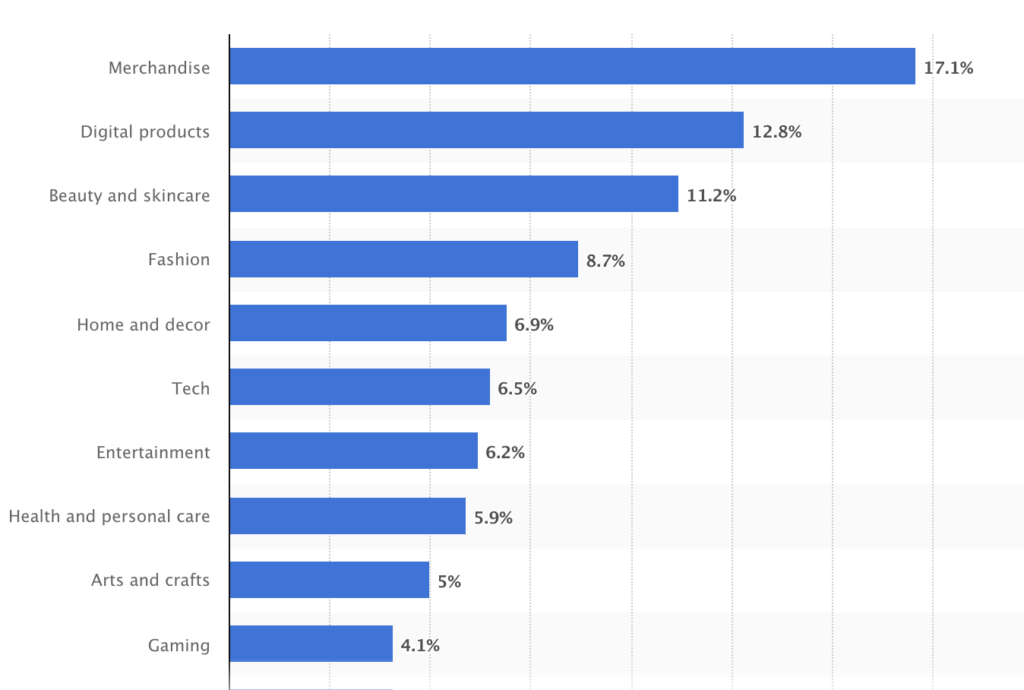
Plus, consumer concerns surrounding sustainability and inclusivity have turned sustainable fashion and inclusive beauty into powerful movements, with content posted about these topics driving higher engagement and brand loyalty.
This has also given rise to a number of key sub-niches like:
- Thrifting
- Size-inclusive fashion
- Vegan beauty
It’s especially the environmental impact of fast fashion that has given thrifting a new lease on life. For example, Sutton Stracke, American businesswoman, socialite, and one of the Real Housewives of Beverly Hills, is showing with her own sustainable fashion brand—Sutton Brands—how fashion can be both stylish and sustainable. By promoting the reuse and repurposing of clothing and opting for timeless classics, influencers like Sutton Stracke, highlights the value of reducing waste and extending the life cycle of garments.
Then, if brands use diverse sizing options and models of varying body types, they can create a sense of belonging among more consumers. When customers see themselves represented, they’re more likely to engage with and remain loyal to those brands.
Just as consumers seek sustainability in fashion, they’re also gravitating towards vegan and cruelty-free beauty products. Like with sustainable fashion, influencers in this niche focus a lot of their content on educating their audiences about the benefits of plant-based ingredients and the importance of ethical sourcing.
In fact, these sub niches can also overlap as this post by Dana, a sustainable fashion and beauty blogger illustrates. While she encourages consumers to switch to vegan-friendly makeup brands, she first asks them to use what’s left instead of adding a usable product to the rubbish bin.
7. Home and DIY Crafting
As high-performing niches like sustainable living and inclusive beauty have shown, social media spaces have become places where personal expression and creativity are celebrated. This helps to give traditional categories like DIY and home décor a new lease on life.
Plus, with environmental consciousness on the increase, many creators are doing exactly that
by upcycling and repurposing old materials. Other trends in home décor, organization, and DIY that make this a high-engagement niche include:
- Maximalism embracing bold colors
- Smart home integrations
- Custom wall art
- Multi-functional living spaces
For example, this paid partnership between Katie Sharpe, who shares DIY tutorials and home décor tips, and remodel.ai, a home renovation and design app, appeals to eco-friendly home renovators, leveraging two high-performing influencer niches simultaneously.
As for the value that these types of posts can offer brands, Sprout Social estimates the earned media value (EMV) at about $1,500 per post.
8. Food and Beverage (Vegan, Clean Eating, and Micro-Cuisines)
Clean-eating and vegan influencers, with their dedicated followings and strong ethical stances, offer a unique appeal. As they’re typically committed to a lifestyle that goes beyond mere dietary preferences, seeing it as a moral or health-centric choice, it’s one of the most authentic influencer niches.
Plus, the global shift towards healthier and more sustainable living has expanded the audience for vegan and clean-eating content. With more consumers interested in plant-based diets and sustainable food choices, these influencers have an expanding reach beyond just niche audiences.
It’s interesting to note how the interest in plant-based diets sharply increases at the beginning of the year, according to Google Trends. Consumers typically add diets as a new year’s resolution, making it an ideal time for brands to launch a campaign with vegan influencers.
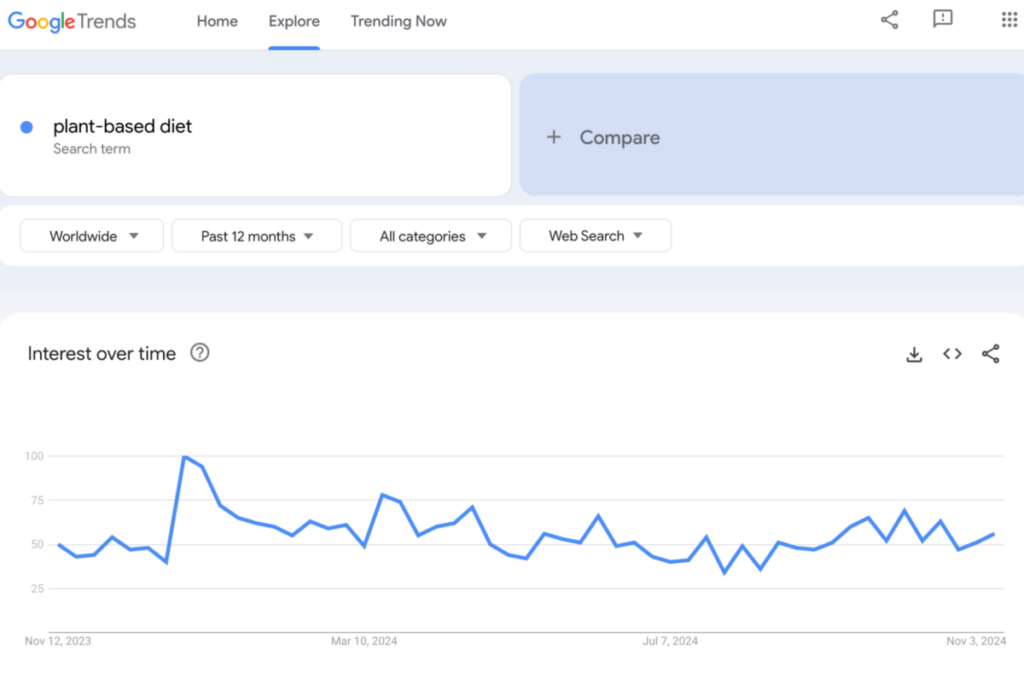
Alongside vegan and clean-eating influencers, there’s also a growing interest in those promoting regional or micro-cuisine content. These influencers bring unique cultural perspectives and flavors to the table, appealing to food enthusiasts eager to explore new culinary horizons.
Regional and micro-cuisine influencers can help brands connect more authentically with local audiences. Their intimate knowledge of local tastes and traditions allows them to create content that resonates on a cultural level, making them ideal partners for brands looking to expand their reach in specific markets, like this campaign between Edwin Tan (aka Dutch Eats) and the burger restaurant Smash Rotterdam to advertise their veggie burger shows.
TikTok and Instagram specifically are great platforms for food brands trying to reach younger audiences. About 70% of Gen Zs have listed TikTok as their most valuable social platform for food recommendations.
9. Luxury and High-end Lifestyle
Few have the luxury to shop for high-end items online. That said, those that can afford, like to engage with brands on social media. About half of affluent consumers across the world either followed, liked, or recommended a luxury brand, as revealed by a global survey about social media activity in relation to luxury brands completed at the beginning of 2024.
Affluent female consumers typically interact more with luxury brands on social media, with more than half engaging with their brands’ content.
These stats show that aspirational content is no longer restricted to glossy magazine spreads or TV ads showing unattainable lifestyles. Luxury influencers are making opulence feel accessible, personalized, and authentic. They share a mix of high-fashion, travel escapades, and fine dining, all infused with a personal touch that invites their followers into their world while maintaining an aura of exclusivity.
Surprisingly, though, it’s younger consumers that engage more frequently with luxury brands. About 60% of affluent consumers in their 20s and 30s interact with luxury brands on social media, compared to only 40% aged 40 and older.
And, it’s not just restricted to likes and comments. About 45% of all luxury goods spending across the world were made by millennials. High-end beauty products in particular are a profitable product category. A 2023 survey reveals that about 70% of US millennials are willing to spend more on luxury beauty products.
10. Technology and Digital Innovation
Tech influencers are skilled at breaking down complex technology into digestible content, often taking the form of unbiased reviews. Not only do consumers trust their honest assessments, but as they have their finger on the pulse of the latest tech advancements their insights guide consumers’ purchasing choices.
When working with influencers in the tech niche, Facebook isn’t the best platform, though. Data shared by Statista puts the average engagement rate for tech and software posts on Facebook at 0.03%, half the overall average post engagement rate of 0.06%.
Moburst, one of the top tech influencer marketing agencies, had great success working with tech influencers on Instagram and TikTok to help Trucaller differentiate its brand and communicate its value proposition. According to the case study about Truecaller’s influencer marketing campaign, it worked out to only $0.04 per view and $0.82 per engagement. Engagement reached 5%, well above the average rate.
11. Travel
About six out of 10 social media users feel that travel influencers are a useful source of information, according to a survey measuring the perceived usefulness of influencers completed in 2024. What’s more, about the same percentage (62%) who use social media for trip planning have booked a trip because of social media content.
The travel niche is equally lucrative for influencers. An analysis completed by Statista Research Department in May 2024 estimates that Alex Ojeda, a top TikTok travel influencer, can earn about $13,500 per post. On average, though, travel influencers charge just over $200 per sponsored post according to Sprout Social, ensuring that it remains a profitable niche for brands.
As for engagement rate, you’re looking at anything from about 2.5% to 3.3% on average. What’s interesting to note is that per Sprout Social’s data the engagement rate for travel influencer content spiked in January 2024 to reach nearly 3.85%. Similarly to how interest in plant-based diets picked up at the beginning of the year, this suggests that an influencer niche like travel also enjoys boosts during certain seasons when consumers are feeling more inspired to plan their next trip.
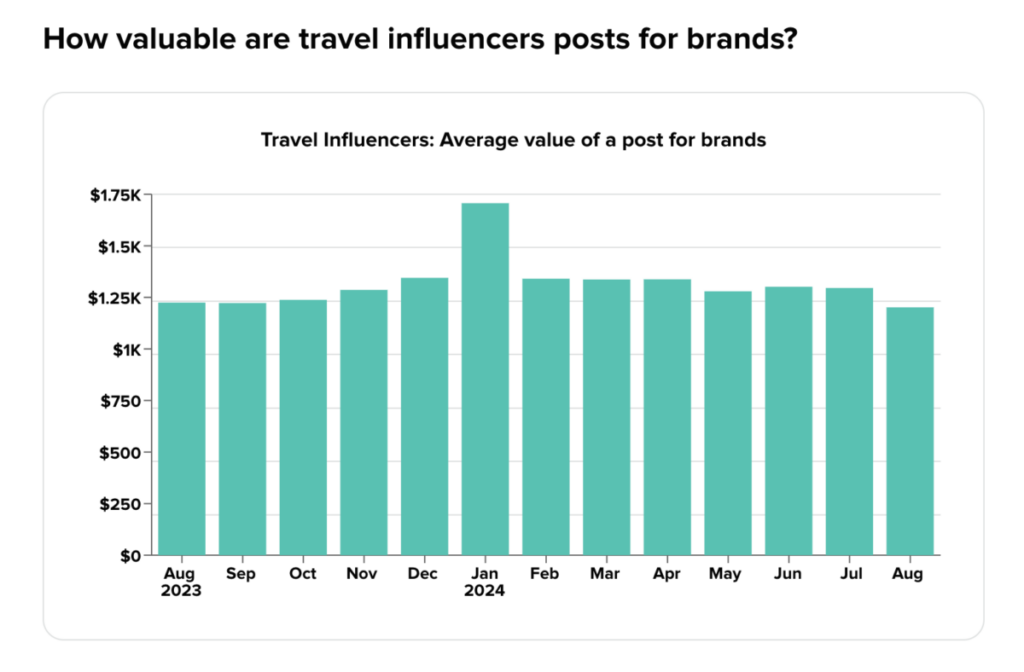
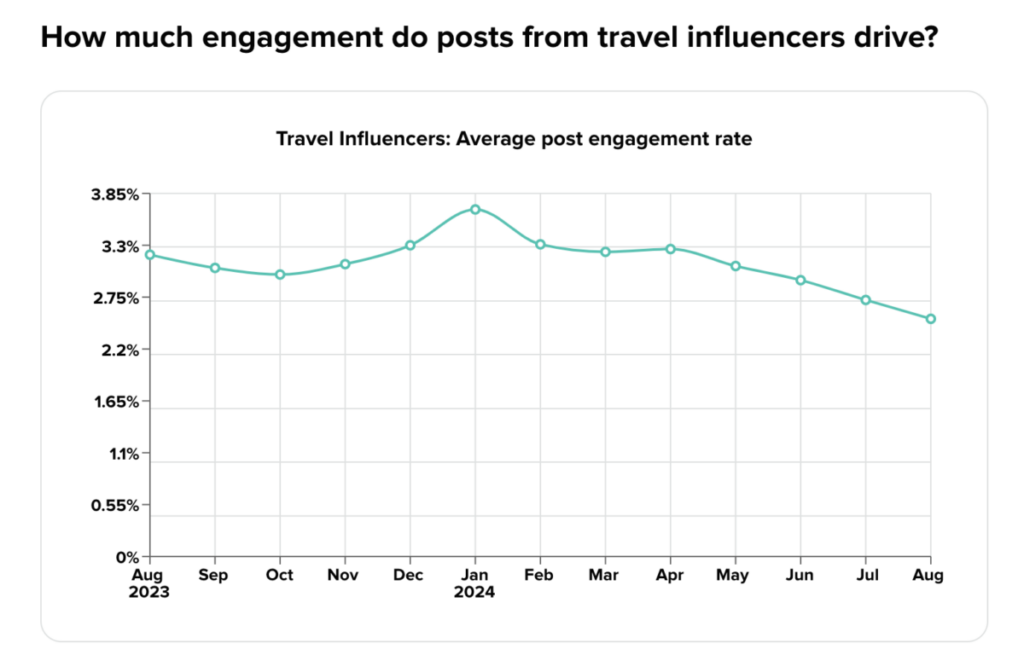
That said, you don’t have to limit yourself to single-digit engagement. A collaboration between Catarina Rivera and Visit Utah reached an engagement rate of 81.9% according to a case study shared by Captiv8.
Key Criteria for a Profitable Influencer Niche in 2024
When evaluating the profitability of an influencer niche, it’s crucial to look beyond follower counts. Key criteria worth considering include:
- Alignment with brand values
- Product-market
- Engagement rates
- The buying power of the niche’s audience
- Long-term growth potential
True success in influencer marketing is achieved when target audiences view influencers as authentic. For this to happen, there needs to be a harmonious alignment between the influencer’s content and the brand’s values.
This establishes a genuine connection between brands, influencers, and their followers which in return builds trust, pivotal in driving audience action.
Not only should values align, but it should also be possible to integrate the product into the content organically. When an influencer’s audience is already interested in a product category, the partnership appears seamless. This natural fit enhances the credibility of both the influencer and the brand, leading to higher engagement rates.
The higher the engagement rate, the more likely audience members are to take action upon influencers’ recommendations.
While brand alignment is key and can drive engagement rate, the actual buying power of the audience should still be kept in mind. After all, likes, shares, and comments aren’t a real currency.
Look for influencer niches with audiences that have disposable income. As influencer campaigns mostly happen online, they should also habitually shop online.
For instance, tech influencers who cater to early adopters with high buying power present lucrative partnership opportunities for brands launching new gadgets.
Beyond immediate sales or engagement boosts, profitable niches also boast an upward trajectory in terms of audience growth and relevance. Niches aligned with emerging trends or growing industries can provide sustained engagement and brand visibility over time.
Platform-Specific Insights: Where These Niches Thrive
To identify the right platform for maximum reach within each niche, you need to understand your audience and analyze their engagement style. It’s a combination of finding the platform where they’re most active and one that suits your style of content (for example, static posts with long descriptions, long-form video reviews, short clips, etc.).
It will take some experimentation. You’ll first start with a few platforms and use platform analytics to test which ones work best.
To help you get started, here’s an overview of which social media platform best supports the most popular influencer niches based on factors like user demographics and engagement styles.
Because of its strong visual nature, Instagram is best for:
- Fashion
- Fitness
- Food
- Travel
- Beauty
While it’s also a popular source for parenting tips (and humor) as well as home décor, keep in mind that its largest audience are aged between 25 and 34 with 28.3% of US users falling into this age group. As such, keep your content aimed at younger parents with toddlers and budget-friendly DIY tips.
TikTok
Like Instagram, TikTok is also an ideal platform for influencers in the following niches:
- Food
- Fitness
- Beauty
- Home décor
One key difference between Instagram and TikTok, though, is that TikTok attracts a younger crowd. According to data about the distribution of TikTok users, about 35% of its global audience are aged between 18 and 24.
As such, keep the content fun and entertaining and let TikTok trends guide you. Think fitness challenges, recipe hacks, and beauty routines.
YouTube
YouTube’s longer video format makes it better suited for influencer niches that require in-depth reviews, explanations, or tutorials like:
- Fitness
- Food
- Travel
- DIY
- Personal finance
- Gaming
- Technology
You would’ve noticed that multiple platforms can support a niche like fitness, for example.
However, to make it work, you’ll need to adjust your content strategy slightly.
For instance, on Instagram, you’ll post a video that demonstrates one stretching exercise or yoga pose, while on YouTube you can share a whole fitness routine that includes this one movement. Then, on TikTok, you can turn it into a fitness challenge.
As YouTube’s more popular among men than women (12.1% are male users between the ages of 25 and 34), tailor your topics to this gender group. For example, instead of sharing your DIY hack for how to turn a wood pallet into a vanity dressing table, rather create a tutorial for how it can serve as a tool box.
While a platform like LinkedIn isn’t necessarily linked with influencer marketing it holds the key to B2B marketing. More than 70% of Linkedin users worldwide are between the ages of 25 and 54.
Technology, venture capital, and investing are some of the most followed hashtags on LinkedIn, making the platform better suited for tech and personal finance influencers.
Key Strategies for Successful Niche Influencer Marketing: Identification, Authentic Partnerships, and Goal Setting
Brands looking to identify the right influencers within a niche need to make data-driven choices. There are a number of free and paid tools that will give you metrics needed for influencer selection.
You can, for example, check out Seopidty’s free niche finder tool. It identifies long-tail and low-competition keywords that you can use to find markets that aren’t as saturated yet and can present more opportunities.
Then, to help you with the actual influencer selection within these untapped markets, you can use influencer analytics tools like:
Once you’ve onboarded relevant influencers, the focus should shift to building a relationship. Influencer marketing is all about authentic partnerships—between brand and influencer and influencer and audiences.
Approach influencers as partners, not just promoters. You should take the time to understand their content and style so that you can feel comfortable to encourage their creative freedom. After all, influencers know their audience best and when their content reflects their unique voice and style that their followers have come to love, you’ll get the best results.
That said, while influencers should be given enough room to be their authentic selves, there should still be clear, niche-specific campaign goals. For example, if your niche is sustainable fashion or living, getting customers to donate to a charity when making a purchase can be just as a big win.
TLDR: People Over Profit Is Driving Profitability
It’s interesting to note that many of the most profitable influencer niches focus on sustainability. For brands to drive profitability, they need to work with influencers who can drive home the message that they’re in the business of making eco-friendly choices.
This theme of sustainability is echoed in several niches. For example, if you’re looking to tap into the home décor market, you’ll need to focus on ideas that incorporate an element of upcycling. Even a niche like fashion that’s traditionally associated with opulence is becoming more inclusive and environmentally friendly.
Sure, topics like travel and tech are still top-performing categories. That said, going forward, influencer marketing campaigns that can find a way to incorporate sustainability organically will thrive.
Frequently Asked Questions
What is the best influencer niche?
Some of the best influencer niches are:
- Health, fitness, and wellness
- Beauty
- Personal finance
- Gaming
- Food
- Technology
- Travel
- Home décor, interior design, DIY, and crafts
- Fashion
- Parenting, family, (and pets)
What are the most profitable niches for social media influencers?
According to data pulled from Sprout Social, fashion is one of the most profitable niches with fashion influencers charging about $2,000 per sponsored post on average. Food and home are also profitable niches for social media influencers with average fee per sponsored post roundabout $1,700.
What platforms are best for different influencer niches?
The target audience and type of content will determine which platform is best for which influencer niche. That said, Instagram and TikTok are typically the preferred choice for fashion, beauty, food, and lifestyle. For niches like technology and gaming that need more comprehensive content like a review or tutorial, YouTube is a better choice. X, on the other hand, is best for influencer niches that depend on news updates like personal finance.
How do influencers monetize their content in various niches?
Here are some ways that influencers can monetize their content:
- Sponsored content
- Affiliate marketing
- Merchandise
- Exclusive content like a paid email newsletter
- Long-term brand partnerships
- Workshops or themed events
Is it possible to be successful in saturated niches like beauty or fitness?
Yes, it’s still possible to be successful in a niche like beauty or fitness where you need to compete against many other influencers. That said, it’s best to narrow your focus and limit your content to, for example, hair products or pilates, or a sub-niche like inclusive beauty. As it will be harder to be profitable, you’ll need to find ways to stand out and differentiate yourself from others. It will also be crucial to stay up to speed with industry and content trends.
Can I switch niches after building a following?
Yes, you can switch to a different niche after you’ve built a following. It’s best to do this gradually by adding a few posts about the new topic at a time. As influencer marketing is all about authenticity, it can also be a good idea to be upfront about your plan and share with your audience that you’ll be starting to post about a different topic.

